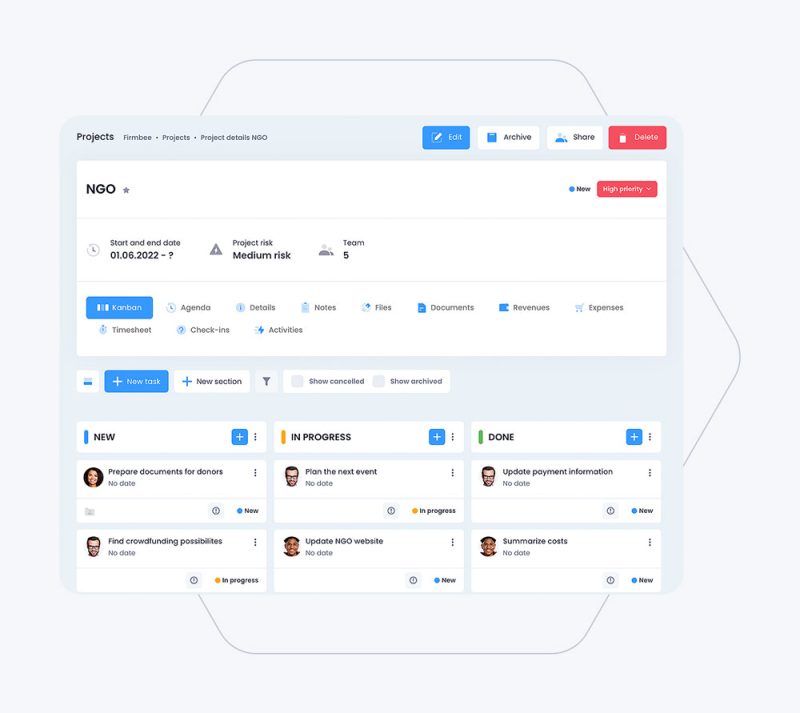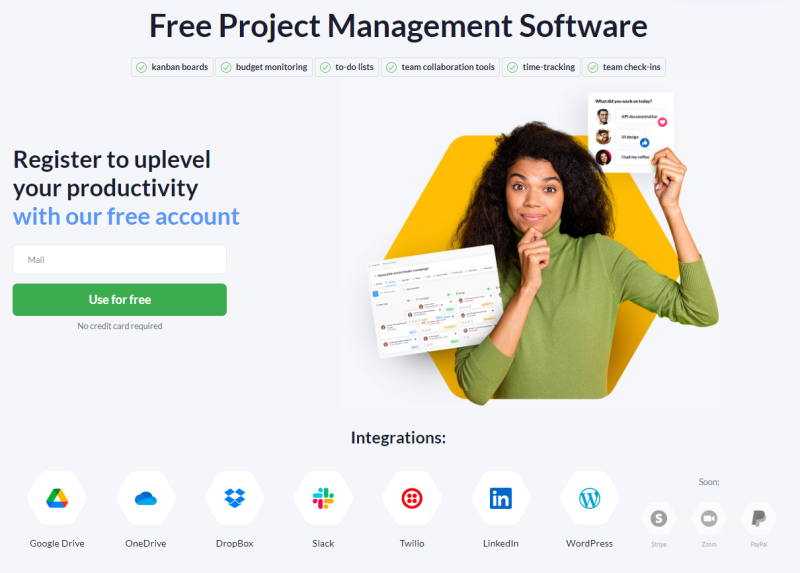The best project management software is one that you can’t see. That one does its job without drawing much attention. It is easy to employ and contains all the necessary functions. But what do these “necessary” functions include? Read on to find out!
The best project management software – table of contents:
- Introduction
- Project templates
- Views
- Integrations
- Areas of operation
- Summary
- Check out our software for project management
How to choose the best project management software? Introduction
Before we move on to discuss specific project management software, let’s consider what functions it should perform. We have divided our today’s issue into three parts. First, we’ll look at the views offered in various programs. In the second, we will consider the integrations needed. And third, we will look at which areas of an organization’s operations such software should cover.
Project templates
Most programs enable you to manage several projects independently. This is worth noting if you are dealing with programs or a portfolio of projects, and if PMs in your organization is dealing with more than one project simultaneously, or if you are running projects with a repetitive flow – then it is worth creating a project template yourself that can be used repeatedly.
However, if you are using the program for the first time, or it is a custom project, you can use the built-in templates. They make it much easier and faster to get started with a new project. This is because they help you start right away in a ready-made environment, pre-configured and designed for project management in, for example, Scrum or Prince2 methodology.
Views
Regardless of the chosen template or method, project management software most often includes standard views. They show the selected aspect of the project implementation clearly. For us, the most important views are:
- Timeline – which can be scaled to cover the entire duration of the project or a selected period,
- Task list – to preview tasks currently in progress, freshly completed, or to perform shortly,
- Calendar – an agenda to schedule meetings and group activities,
- Analytical tools – that is, charts and data visualizations of specific areas of project execution and the workload of individual team members to generate reports,
- Team – a list of people involved in the project with contact information.

Integrations
When choosing a project management program, attention is less often paid to integrations, that is, what programs and applications our tool work with. This is because some management programs, such as Firmbee, are monoliths. This is a platform that provides comprehensive support for all project-related tasks – from task lists and notes to handling invoices and even the team recruitment process.
Sometimes, however, a program that facilitates project management functions as a set of so-called microservices, that is, a set of cooperating modules that can be turned on and off. In this case, integrations prove to be very useful. These can include connections to, for example:
- external calendars (for example, Google or Apple Calendar), making it possible, for example, to send meeting invitations,
- communicators – such as Microsoft Teams, Zoom, or Slack, making it easy to communicate without having to copy or move content,
- readers of various formats, so you can easily preview the contents of documents or image files,
- email – to add tasks directly by mail,
- sales tools for e-commerce, such as Salesforce, Zoho Desk, and Zendesk,
- the cloud to store and share larger project files
- security and authorization tools are essential especially when working from outside the office and having less secure Internet connections,
- specialized reporting tools, such as Power BI, Looker, or Google Sheets, for example.
When choosing a particular program, it is also worth asking yourself whether it will only work on a computer or whether it also has a mobile app.

Areas of operation
The primary areas of project execution supported by the software are task management over time, as well as budget visualization. However, depending on the type of project being implemented, modules such as:
- contacts – especially if the project implementation includes cooperation with freelancers or multiple client representatives,
- campaigns – when marketing or sales activities are part of the project,
- documents – when it is necessary to share different materials,
- human resources – an option that is particularly useful when a project team is being formed or staff needs to be replenished during project implementation,
- finances – in addition to the overall status of the project budget, it is useful to have at hand a tool that allows you to collate expenses for various purposes, or to compare offers of products and services necessary for the project.
Summary
The essential functions that project management software should perform are to facilitate work organization and planning. Using templates – whether built-in or self-created – makes it much easier to get started. And clear views depicting specific aspects of a project’s execution make daily tasks more pleasant and simple. Integrations, meanwhile, mean that we can use our favorite software by combining it with the one we use to manage the project. Unless, of course, it’s sophisticated enough to combine modules that allow for communications, financial management and HR.
Check out our software for project management:
If you like our content, join our busy bees community on Facebook, Twitter, LinkedIn, Instagram, YouTube, Pinterest, TikTok.
Author: Caroline Becker
As a Project Manager, Caroline is an expert in finding new methods to design the best workflows and optimize processes. Her organizational skills and ability to work under time pressure make her the best person to turn complicated projects into reality.
The most important questions
-
Are Kanban boards part of project management software?
Very often the view of a list or queue of tasks is in the form of Kanban boards or similar. Sometimes the software gives you the option to add custom columns to place jobs with a non-standard status, such as "in review" in the case of a project where the tasks consist of preparing texts.
Getting started with project management:
- What is a project?
- What is project management?
- How to manage projects?
- Project management methods
- Types of projects
- 4 examples of projects
- Prioritization of projects
- Areas of project activity
- Definition of success in project management
- Why use project management software?
- How to choose the best project management software?
- Overview of project management software
- Project life cycle
- What is the project vision for?
- Project goal. What is it and how to define it well?
- Project initiation phase - what to pay attention to?
- The domain of planning in project management
- What is a project schedule and what is it for?
- How to use milestones in a project?
- Project execution
- How to prepare a successful project contingency plan?
- Importance of project closure
- Project failure. 5 reasons why projects fail
- 4Ps of management: project, product, program and portfolio
- Most important tasks and responsibilities of the Project Manager
- Most useful project manager skills
- How to become a project manager?
- 5 books every project manager should read
- How to set up a project team?
- Work breakdown structure - how to delegate work in a project?
- How to lead a team during hybrid work?
- Challenges project managers face when working with a team
- Types of project meetings
- Project monitoring. What parameters to watch?
- How to write a compelling
- How to define the scope of a project and avoid scope creep?
- Feasibility study – can we implement this project?
- Risk analysis in projects and tools to facilitate it
- How to create a project charter?
- What is a stakeholder register?
- Gantt chart in project management planning
- How to create a project budget?
- Time management in project
- How to create a project risk register?
- Project risk management strategies
- Project marketing
- Sources and areas of change in the project
- Project management change models
- What's after Agile? Methods in project management


















